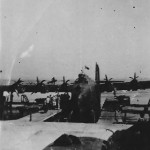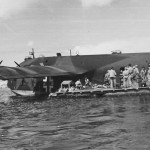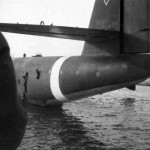Wing-mounted turret of BV 222V-5 “Wiking”
BV 222 “Wiking” frontal view
Blohm & Voss BV 222V-8 “Wiking” of the LTS 222
MG 157 turret on BV 222V-3 of the LTS 222
Blohm & Voss BV 222C-09
Blohm & Voss BV 222V-7 TB+QL
BV 222 V-3
BV 222 of the Lufttransportgruppe (See) 222 at Tarent
Blohm & Voss BV 222C-010 fitted with radar
Prototype BV 222 V1 in flight
BV 222 V8 “S8” of the Lufttransportgruppe (See) 222
frontal view of a BV222 6
BV222 flying boat
Blohm & Voss BV222 V1 in flight
BV222 Wiking side view
Blohm & Voss BV222 V3 coded X4+CH, 1942/1943
Blohm & Voss BV222 top
Blohm & Voss BV222 8
BV222 V3 X4+CH
Fuselage of the captured flying boat BV222 in Hamburg, 1945
Blohm & Voss BV222 tail
BV222 der LTS See 222 Tarent 1943
Tail of anchored German flying boat Blohm & Voss BV222
Blohm & Voss BV 222 “Wiking” anchored on the water
Blohm & Voss BV 222 “Wiking” was a large, six-engined German flying boat of World War II.
Total production: 13.
History
Deutsche Luft Hansa ordered three of the large BV 222 boats in 1937 for use on the North and South Atlantic. The prototype V1 D-ANTE was civil, but after initial flight trials was modified into a freight transport for the Luftwaffe. There followed nine further aircraft, no two alike. V9 also being the first of four production 222C-0 transports with Junkers Jumo 207 C engines and improved armament (including unusual wing-mounted turrets), as well as FuG 200 Hohentwiel radar and FuG 216 rear warning. Only 13 Wikings were flown, and decision to drop the diesels led to a switch to the BMW Bramo 323 R Fafnir, used in the majority of the prototypes. from No 20. which with 14-19 were almost complete From 1941 the Wikings shuttled from northern Norway to Africa bringing urgent stores. Despite their improving equipment, nearly all were shot down or destroyed at their moorings, but four survived to 1945.
Wiking was the largest flying-boat to see service during the war.
Design
Wings: high-wing cantilever monoplane. All-metal structure with a single tubular spar. The spar was sub-divided to contain six fuel tanks. Wing spar measuring 1,45 m (4 ft. 9 in.) in diameter. A passage inside the wing gives access to the engines in flight. Electric de-icing equipment.
Hull: all-metal two step hull covered with corrosion-resisting alloy sheet varying the thickenss from 3 to 5 mm. It was divided into two sections, the lower for passengers or cargo and the upper for the flight crew. The all-metal wing tip stabilising floats are split, vertically, each half retracting outwardly flush with the underside of the wing. Electric retraction.
Tail: cantilever monoplane type. High tapering single fin with tailplane mounted slightly above the top line of tho hull. The rudder was operated by two interconnected tabs driven by the main circuit. All-metal structure.
Bibliography
- Heinz J. Nowara: Luftgiganten uber See Bv 222 – Viking – Bv 238, Waffen-Arsenal Band 63 (german)
- Heinz J. Nowara: Blohm & Voss Bv 222, Schiffer Military History
- Blohm & Voss BV 222 “Wiking” – Flugzeug Profile 40 (german)
- Rudolf Hofling: Blohm & Voss Bv 222 “Wiking”, Schiffer
- Waldemar Trojca: Blohm & Voss 222 Wiking – Im Detail (german)
- Manfred Griehl: Typenkompass Blohm & Voss (german)
- Hermann Pohlmann: Chronik eines Flugzeugwerkes, 1932-1945: Blohm u. Voss Hamburg, Hamburger Flugzeugbau GmbH, (german)
- Marian Krzyźan: Blohm & Voss BV 222 & BV 238, AJ-Press Monografie Lotnicze 29 (polish)
- Adam Thompson: Seeflieger – Luftwaffe Maritime Aircraft and Units 1935-1945, Luftwaffe Colours
- Brian Philpott: German Maritime Aircraft – World War 2 Photos Album Number 18
- David Donald: Warplanes of the Luftwaffe, Barnes and Noble 1994
- R. Smith, Antony L. Kay – German Aircraft of the Second World War, Putnam 1990
- Jane’s Fighting Aircraft of World War II























